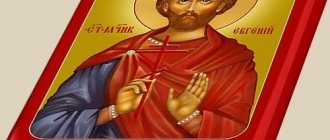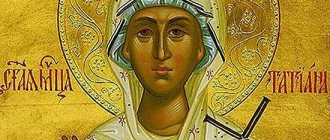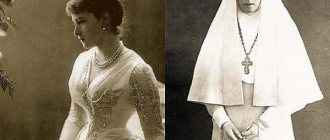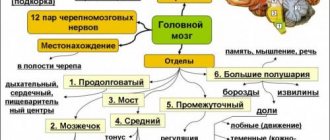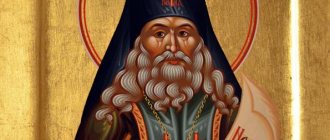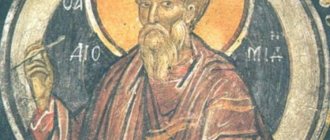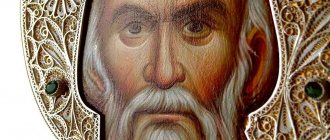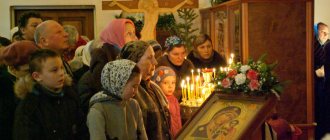Often in our lives there are situations when we are faced with an important choice, or doubts begin about some action. In such cases, we try to drive away such doubts from ourselves, or postpone the choice until tomorrow. But this is not recommended. Why didn’t anyone think about the fact that prayer to St. Helena Equal to the Apostles could help?
Helen Equal to the Apostles was the mother of the ruler of the Roman Empire. It gained fame in peasant circles due to the spread of the peasantry and the conduct of archaeological operations. At which, it was believed, the cross of the son of God was discovered. In memory of her and her wonderful deeds, many churches were built in the world.
Leonid of Corinth (March 23, April 29)
Leonidas was one of the martyrs who died in Corinth in 258, during the time of the ruler Decius. Beginning in 250, Christians were persecuted in the city. All believers who refused to renounce their beliefs were martyred.
Saint Leonidas was one of the disciples of Kondrat, a deeply religious man who, in the desert near Corinth, gathered hundreds of people around him. When the Roman military leader Jason arrived in the city to execute the followers of Jesus Christ, the young man, along with other novices, suffered martyrdom. This happened on the first day of Easter in 258. First, the martyrs were thrown into the water. But they did not drown, but stood up and walked with their feet along its surface. Then the tormentors boarded the ship, caught up with the people, tied ropes to their necks and finally drowned them.
Leonid's name day is celebrated on March 23 and April 29. On this day the church remembers him and the other martyrs of Corinth.
What do they pray for in front of the Orthodox icon of St. Eugene - philosophy
The name Eugene is translated from Greek as noble, noble. The Orthodox Church venerates many saints who bear this beautiful name. The most famous of them is the holy martyr Eugene of Sebaste.
He lived during the era of Emperor Diocletian in the city of Sebastia, located on the territory of modern Armenia. The period of Diocletian's reign was marked by a surge of paganism, iconoclasm and persecution of Christians.
For his fearless confession of Christ, his accusatory speeches against the emperor and his defense of icons, Saint Eugene was subjected to terrible torture, from which he soon died. His memory is celebrated on December 26.
At one time, it was accepted in icon painting that all the saints who bore this name were reduced to one common image, and the icon of St. Eugene, as a rule, did not have other clarifying inscriptions. Now in churches you can see personalized icons of St. Eugene of Melitino, St. Eugene of Damascus, and St. Eugene of Caesarea.
Help in sorrows and illnesses from the icons of St. Eugene
Since ancient times, people have resorted to the miraculous icon of St. Eugene, asking for help in poverty and need, in various troubles and bad weather. They ask him, as someone who suffered for the name of Christ, to strengthen faith, prudence and the ability to correctly see a difficult situation.
For bearers of the female version of the name, there is an icon of St. Eugenia, which will help protect against lies, slander, anger and betrayal. They also ask this saint for help in healing from illnesses. This is connected with the life story of Saint Eugenia of Rome.
At a young age, she secretly received holy Baptism from everyone and went to asceticism in a monastery, taking on the image of a young monk and calling herself by this name. Soon she was forced to open up and for many years she served the sick and poor, converting those around her to the Christian faith, until Emperor Gallienus began a new persecution of Christians.
Then the saint was tortured and then executed. The day of her veneration is January 6. On the church icon she is depicted as a young nun.
Home prayer in front of the icons of St. Eugene
You can pray in front of the icons of Saint Eugenia not only in church, but also at home. You can get a personal icon in various ways - purchase a ready-made one in a specialized Orthodox online store or make an individual order from an icon painter.
Needlewomen will be pleased to embroider the icon of St. Eugene on their own - with beads or threads. Currently, there are many carefully developed patterns for this image, designed for embroidery in both techniques, which will greatly facilitate the painstaking work of craftswomen.
Leonid's name day according to the church calendar is June 18. Leonidas of Egypt
Martyr Leonidas comes from a noble Roman family. He was well built, handsome, and from an early age possessed true faith in the Lord. For this he later accepted the death of a martyr.
During the reign of Emperor Maximian (from approximately 305 to 311), persecution and extermination of Christians continued. They were brutally tortured, forcing them to renounce their faith, and if this did not happen, the people were killed. Among them was the martyr Leonidas.
He and other believers, among whom were Marcian and Nikander, were seized and began to be brutally beaten with rods. Then they threw me into prison, did not give me any water or food, and continued the abuse. The martyrs did not renounce their faith in the Lord, and one day an Angel appeared to them and healed their wounds. Having learned about this, many pagans converted to Christianity.
The martyr died in prison from hunger and thirst on June 18. The place of his burial is unknown. On this day Leonid's name day is celebrated. On June 18, the Holy Church remembers the martyr Leonidas of Egypt.
Pros and cons of the name Leonid
What positive and negative aspects can be noted in the name Leonid? Its advantages are that it is rare, unusual, beautiful, goes well with Russian surnames and patronymics, and also has several euphonious abbreviations and diminutive forms, such as Leda, Leonidushka, Leonidochka, Ledochka, Nida, Nidochka. However, parents choosing a name for their daughter may have great doubts because of the complex and sometimes too eccentric character of many of its owners.
Health
Leonida's health is quite good, although she does not monitor it.
Love and family relationships
In family relationships, Leonida shows jealousy and even despotic behavior towards her loved ones, so often the marriage of the owner of this name cannot withstand her emotional onslaught. Leonida also does not have a close and warm relationship with children, although in adulthood they often become close to their mother.
Professional area
As for the professional sphere, the active Leonida would be suitable for work as a waitress, manager, restaurant manager, travel agency employee, organizer and host of events, circus or theater performer, animator.
Leonid Ustnedumsky (July 30)
Leonid Ustnedumsky was born in 1551 on Yaroslavl land into a peasant family. He grew up a believer in the Lord and a literate person; his parents taught him to read as a child. Leonid led the ordinary life of a peasant, engaged in farming, and attended church. But one day, at the age of 50, the Mother of God appeared to him in a dream and told him to go to the Morzhevskaya Nikolaev Hermitage, take there the icon of the Mother of God Hodegetria and move it to Mount Turin, which is located on the Lusa River.
The elder considered himself unworthy of such a Divine revelation and did not go anywhere. But soon he took monastic vows at the Kozheezersky monastery in the Arkhangelsk region. The Mother of God appeared to Leonid in a dream three more times until he finally followed her instructions.
Soon, in 1608, a church was erected on the indicated site in honor of the Entry into the Temple of the Blessed Virgin Mary. Later the icon of Hodegetria was transferred to it. The hieromonk died on July 30 (new style) 1654. On this day Leonid's name day is celebrated. During the service on July 30, the Orthodox Church remembers Hieromonk Leonid.
Saint Tatiana: the life of the Great Martyr, what is asked for in front of icons and prayers
The life of the saint was written in the 17th century by Dmitry of Rostov. Dmitry Rostovsky wrote that Tatiana lived in the 3rd century. Saint Tatiana was born in Rome into a rich and wealthy family.
Her father was consul three times, and this meant a lot in those days. The girl's parents were Christians and raised their daughter in piety and purity.
But they had to hide their faith in order to stay alive.
Dmitry Rostovsky wrote a life about the holy martyr Tatiana in the 17th century
When the girl was still little, she said that she really wanted to be a saint. She asked God to teach her to be pleasing to him in everything. “...I want to be a saint. Teach me, Lord, not to love anything or anyone as deeply as You! Teach me, Lord, to do only what You please; make me Your servant..." It happened just as she wanted.
LEONID
Prmch. Adrian and etc. Leonid Poshekhonsky. Icon. 2nd half XIX century (Cathedral of the Epiphany in the Holy Dormition Hadrian Monastery, Poshekhonye)
Prmch. Adrian and etc. Leonid Poshekhonsky. Icon. 2nd half XIX century (Cathedral of the Epiphany in the Holy Dormition Hadrian Monastery, Poshekhonye) Several icons depicting the founders of the Poshekhonsky Dormition Monastery abbot have been preserved. Adrian and L., presented on the banks of the river. Vothi, the site of the founding of the monastery. L. is an elder with a beard streaked with gray long to the middle of his chest, with flowing gray hair down to his shoulders, in monastic robes (tunic and mantle, without schema and stole), with his head uncovered. He stands behind St. Adriana. This kind of “secondary importance” is reflected in the short mention of L. in the description of the appearance of the saint. Adriana in the iconographic original of the Con. 18th century: “He sat upon the shoulder of Kozmina, in the schema, the monk’s robe. And his companion, the Monk Leonit, the elder of the Assumption Monastery" (BAN. Strict. No. 66. L. 89 vol., under March 17).
On an icon from the 1st third of the 19th century. (53.5 × 44.3 cm), originating from the Uspenskaya cemetery church. on the outskirts of the town of Poshekhonya (built at the expense of parishioners in 1822 on the site of a wooden church (1773)), St. Adrian and L. are depicted on the right on the bank of the river, next to them is a beardless young man, with the comeliness of his appearance reminiscent of an angel - the “monk Bestuzh” mentioned in the Life, who led the monks to the site of the future monastery (only St. Adrian has a halo in the form of a thin whitewash line ; in the inscriptions above the heads the names of both saints are indicated). On the left is a tall oak tree, in the crown of which stands an icon - a reflection of the text of the Life of St. Adrian that St. the fathers on the tree “placing the image of the Dormition of the Blessed Virgin Mary, bringing it with them from the monastery” (The Life and Suffering of the Holy Primarch Adrian Abbot, Poshekhonsky Wonderworker // Yaroslavl EV. 1873. Part unofficial. No. 4. pp. 27-29 ) (according to another version, the icon was found on a tree). In the 2nd plan, near the oak tree, there are the buildings of the monastery: fortress walls and towers with a gate bell tower, as well as churches - Uspenskaya on the left (not preserved) and Epiphany on the right. The image of the monastery on this icon apparently appeared later; it is distinguished by its dry graphics and sparse color scheme. Shown on a small scale, two people with a net in the river and one near an oak tree are the fishermen mentioned in the Life, who placed in front of the icon “bread and the great fish from the fish that were then caught” (Ibid.), depicted on a tree branch.
The same iconography is known from two more icons of Saints Adrian and L. - from the collection of F. R. Komarov (Yaroslavl, 1st half of the 19th century) and in the Epiphany Church of the Poshekhonsky Assumption Monastery (2nd half of the 19th century; 59.5×45.5 cm; reliquary mounted). The compositions of the icons are similar: there is no image of the “monk of Bestuzh”, the river is shown not in the foreground, but behind the tree, the buildings of the monastery are enclosed in a fence, deployed in a perspective plan; with a halo also only St. Adrian, and on the icon from Komarov’s collection, the image of L. does not even have a signature.
Icon from the Assumption Church. seems to be the most original processing of the text of the Life into iconography (despite the initial absence of an image of the monastery on it). The icon painter sought not only to convey the story literally, but also vividly. For example, he turned the episode with the fisherman who left fish and bread on the tree into a small scene: the fisherman climbs down from the tree, holding onto its branch with both hands, and one of the branches has already been broken and lies on the ground. On the icon from the collection of F.R. Komarov, the image of the same fisherman was modified into the image of a kneeling youth with his hands folded in prayer on his chest, looking tenderly at the icon.
In Epiphany Church. In the Assumption Monastery there is an icon created before 2006 (50x40 cm, placed in a frame and icon case), on which the Poshekhonsky saints are collectively represented: Sebastian, Leonidas, Adrian, Anna and Peter. The author's style of writing can be traced in the painting of the faces. The hand gestures are varied, the figures are elongated, placed close to each other, the halos are bright and gilded. In the background is the Mon-Rya Con ensemble. XIX century
Icons with a single image of L. in the present day. time not detected.
Lit.: Markelov. Saints Dr. Rus'. T. 2. P. 40.
L. L. Polushkina
